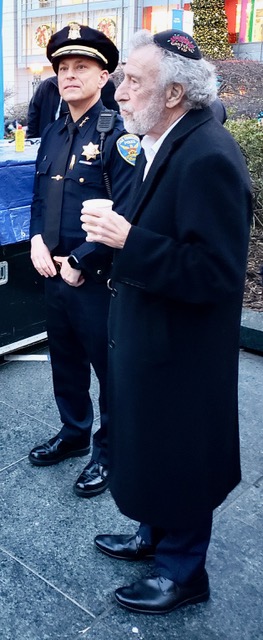One woman started an organization that books free professional entertainment in hospitals, senior centers, special-needs schools, and prisons. Another founded an educational facility that aids ex-felons, prostitutes, alcoholics and addicts.
One guy has given away suits and ties to homeless men, as well as to poor ones with homes, to help them get jobs. Another challenged Major League Baseball’s restrictive “reserve clause,” action that led to players becoming free agents in all pro sports.
Those four are among seven who’ll be honored May 31 by a new Bay Area project, the Mensch Hall of Fame.
You may have heard the Yiddish word “mensch” but have some trouble pinning down its meaning. According to one online dictionary, it’s a label for a person of honor or integrity. Rabbi Yosef Langer, who has led the fervently orthodox Jewish San Francisco Chabad-Lubavitch community for decades, is happy to expand on that definition.
“A mensch,” he says, “is somebody who has the quality of caring for himself and his fellows, for the community and humanity, a person who’s honest, respects others, is compassionate and kind, and is genuine in who they are and what they do.”
Awardees of The Mensch Hall of Fame’s inaugural event will be three women and three men — plus another woman who’ll get lifetime achievement honors.
The awards dip into the worlds of philanthropy, social activism, charity, sports and politics.
Recipients are Mimi Silbert, Tiffany Shlain, the late Mimi Fariña, George Zimmer, Josh Becker and the late Curt Flood — with Dolores Huerta getting the lifetime award.
Though the 79-year-old Langer and his 38-year-old son, Rabbi Moshe Langer, run the project, it was the brainchild of Brian Webster, who volunteered for Chabad for a decade before he became a paid employee a few years ago. To stay with the theme, the elder Langer says of Webster, who once worked for the late rock promoter Bill Graham at the Fillmore, “He’s a mensch.”
Proceeds from the event will benefit The Giving Kitchen, which, according to Moshe Langer, “provides food for financially challenged people,” and the Bill Graham Menorah Project, which is responsible for lighting the huge menorah in Union Square each year and includes a new program “where we gave out 1,000 menorahs last year to spread even more light.”


Graham had financed the first lighting of the Union Square menorah, a one-day Chanukah event in 1975. The annual affair there now lasts the entire eight-day length of the holiday.
Chabad, adds Yosef Langer, is now also heavily invested in Noah’s Ark on the Bay, a project that fosters mensch-hood all over the globe, “outreaching beyond the Jewish community — to enlighten, not to proselytize.”
To determine who should receive Hall of Fame honors, the younger Langer says organizers “looked for people in the community that have shown a good deal of mensch-behavior (philanthropy, charity, volunteering).”
Zimmer — the suit-and-tie guy who started the Men’s Warehouse “from the ground up and created an environment where people were happy to come to work, and who started a fund to send the children of workers to college” — was the first selected.
The posthumous awards are going to Fariña, who started Bread and Roses, the organization that sends 1,000 musicians and performers each year to close to 100,000 isolated audience members, and Flood, who sacrificed his baseball career in pursuit of better negotiating positions for players.
The lifetime achievement award to Huerta, 93, recognizes her civil rights and labor activism, including co-founding the National Farmworkers Association, a predecessor of United Farm Workers, with Cesar Chavez.
The other mensch awards go to state Sen. Becker, D-San Mateo, who co-founded New Cycle Capital, a pioneer in building socially responsible businesses; Silbert, who founded the educational Delancey Street Foundation, which supports substance abusers and ex-convicts via academic, vocational and social programs; and Tiffany Shlain, an independent filmmaker and internet pioneer.
Chabad-Lubavitch of San Francisco, which has long been known for its creativity, is part of an international movement with roots in the Hasidic movement of the 18th century that runs an extensive network of educational and social services. Some 3,000 Chabad centers exist in more than 65 countries.
The Inaugural Mensch Hall of Fame Awards, VIP Reception, Auction & Dinner are at 6 p.m. May 31 at The Mint, 85 Fifth St., San Francisco. Tickets are $200. For details, call (415) 668-6178 or visit https://menschhalloffame.org.
This story was first published on LocalNewsMatters.org, a nonprofit site supported by Bay City News Foundation http://www.baycitynews.org/contact/.
Woody Weingarten, a longtime member of the San Francisco Bay Area Theater Critics Circle, can be contacted by email at voodee@sbcglobal.net or on his websites, https://woodyweingarten.com and https://vitality press.com.





























